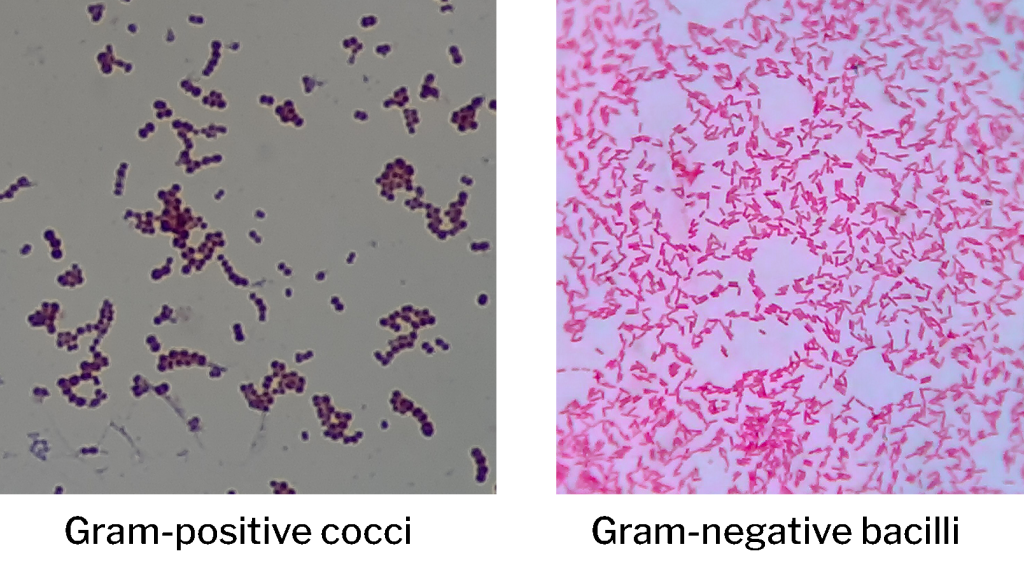6.0 Infectious Diseases in Fish
6.7 Infectious Agents of Fish
Infectious disease agents in fish are in the same categories of pathogens as other animals. In this chapter, bacteria, viruses, and fungi will be discussed.
Understanding Bacterial Pathogens in Fish
To effectively manage bacterial diseases in fish, it’s essential to have a basic understanding of microbiological classification. Bacterial pathogens are initially categorized based on their staining characteristics, typically using the Gram staining method. This laboratory test helps distinguish between Gram-positive and Gram-negative bacteria under a microscope. The Gram staining process involves four fundamental steps: the application of crystal violet as the primary stain, Gram’s iodine as a mordant, alcohol or acetone as a decolorizer, and safranin as a counterstain.
- Gram-Positive Bacteria: These bacteria have a thick peptidoglycan layer in their cell walls, which retains the crystal violet stain, resulting in a purple to blue coloration. Gram’s iodine enhances the contrast between Gram-positive and Gram-negative bacteria.
- Gram-Negative Bacteria: Gram-negative bacteria possess a thinner peptidoglycan layer, which does not retain the crystal violet stain, causing them to appear red to pink when stained with safranin. The decolorization step helps differentiate between the two groups.
The image below illustrates a gram-positive and gram-negative stain under a light microscope.

It’s important to note that while Gram staining provides valuable information about bacteria, it typically doesn’t lead to a definitive diagnosis on its own. Instead, it guides practitioners toward suitable treatment methods.
Some bacterial pathogens have cell walls resistant to most staining compounds. One such method used for these cases is acid-fast staining, which is employed for pathogens like Mycobacterium spp. Acid-fast staining involves carbolfuchsin as the primary stain, alcohol or acetate for decolorization, and methylene blue as a counterstain. Acid-fast organisms retain the red color of the primary stain, while non-acid-fast organisms stain blue.
Common Bacterial Pathogens in Fish
Now, let’s explore some of the most common bacterial pathogens in fish, along with their associated clinical signs, hosts, diagnoses, and treatments:
1. Streptococcus iniae & S. agalactiae
- Gram Type: Gram-positive
- Hosts: Tilapia (S. iniae), cattle (S. agalactiae)
- Clinical Signs: Acute cellulitis in humans (S. iniae), mastitis in cattle (S. agalactiae)
- Diagnosis: Chaperonin 60 gene identification method (S. iniae), clinical observation (S. agalactiae)
- Treatment: Antibiotics for human infections, biosecurity measures for livestock (S. iniae), antibiotics for mastitis (S. agalactiae)
2. Flavobacterium spp. (F. columnaris, F. branchiophilum, F. psychrophilum)
- Gram Type: Gram-negative
- Hosts: Various fish species
- Clinical Signs: Columnaris disease (F. columnaris), bacterial gill disease (F. branchiophilum), tissue necrosis and hemorrhagic lesions (F. psychrophilum)
- Diagnosis: Bacterial culture and identification
- Treatment: Water treatments, antibiotics, and other therapeutic measures
3. Aeromonas spp. (A. hydrophila, A. salmonicida)
- Gram Type: Gram-negative
- Hosts: Freshwater and brackish water species (A. hydrophila), cold water fish (A. salmonicida)
- Clinical Signs: Hemorrhagic lesions, septicemia
- Diagnosis: Clinical observation, bacterial culture
- Treatment: Antibiotics, water treatments
4. Yersinia ruckeri
- Gram Type: Gram-negative
- Hosts: Warm water fish, salmonids
- Clinical Signs: Enteric redmouth
- Diagnosis: Clinical observation
- Treatment: Varied
5. Mycobacterium spp. (M. marinum, M. fortuitum, M. chelonae)
- Staining: Acid-fast (do not stain consistently with Gram stain)
- Clinical Signs: Behavioral changes, skin alterations, granulomatous lesions, spinal curvature defects
- Diagnosis: Clinical observation, bacterial culture
- Treatment: Long-term antibiotic therapy
Understanding these bacterial pathogens and their characteristics is crucial for effective disease management in fish populations. It’s also important to note that some of these pathogens can pose risks to humans, emphasizing the need for proper precautions and biosecurity measures.

